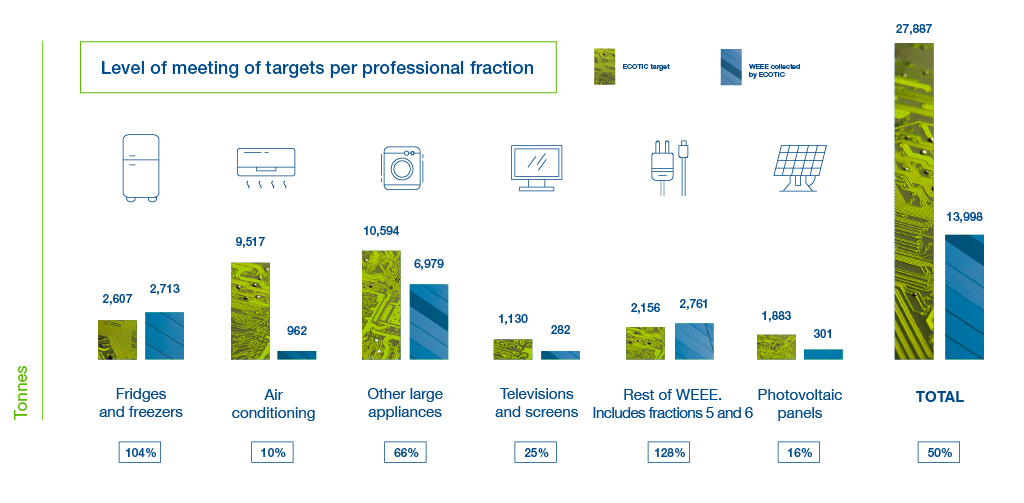Oriented towards great management and excellence
Víctor Martínez | Operations Manager

Víctor Martínez | Operations Manager
This FY closed with a total of 107,341 tonnes financed and managed through our Extended Producer Responsibility Collective System (EPRCS). A significant volume of waste electrical and electronic equipment which, added to the total managed to date since 2005, exceeds 1,100,000 tonnes.
The results are encouraging us to continue to offer a service based on great management, partnership and excellence and, furthermore, to continue to innovate in order to improve our process for the benefit of producers, partners and public authorities that put their trust in ECOTIC.
The great management carried out is also reflected in the almost 10 million tonnes of CO2 equivalent of greenhouse gas emissions that we have avoided at ECOTIC Foundation, a significant figure that scontributes to the improvement of the environment.
While a year ago we were delighted to have managed to surmount the barrier of one million tonnes managed by ECOTIC since its founding in 2005, in 2022 we have reached another major milestone by surpassing one thousand member producers. Specifically, 1,034 producers at the end of the year, an unprecedented growth of 19.5% compared to the 867 in 2021. This figure is particularly relevant as it is an indicator of how producers of electrical and electronic equipment value us and how they perceive our management offer.
In the household market, we managed a total of 93,343 tonnes of WEEE in 2022, reaching a cumulative total of 1,107,380 tonnes since the start of our activity.
Continuing the historical trend, distributor points are still the main waste collection channel, accounting for 52.2% of the total WEEE collected. Recycling centres and municipal collection centres accounted for 28.4% of the total and collection by installers, technical services, waste companies or managers, etc. accounted for 19.4%.
As for the evolution of collection points, after a two-year hiatus, they have grown by 5.3% compared to 2021, reaching 10,169, a figure very close to the pre-pandemic figure.
Of the total waste collected, we were able to allocate a total of 1,306 tonnes of WEEE to the preparation for reuse, which, added to those allocated to this process since 2017, make a total of 12,369 tonnes, a figure that is increasing and which is key to developing the circular economy model.
In the case of fraction 6, corresponding to small IT and telecommunications equipment, the percentage allocated for reuse stood at 6.5% of waste, a figure that, as in recent years, is significantly higher than the 4% established in Royal Decree 110/2015.
In fraction 4, which groups waste from large household appliances, the figure achieved for reuse is 1.2% with a total of 436 tonnes destined for reuse.
In fraction 1, which includes temperature exchange equipment, we are continuing to increase —despite not having set any target — the quantities allocated to reuse, this standing at 1.9% of the total.
Evolution of WEE quantities managed

In reference to the waste managed from the professional sector, the sustained growth that we have historically recorded continues, reaching 13,998 tonnes, an increase of 11.7% compared to the result obtained in 2021.
By fractions, large household appliances account for 49.8% of the total collected, followed by the rest of WEEE, which includes fractions 5 and 6, standing at 19.7%.
Evolution of WEE quantities managed

WEEE household sector 2022
WEEE professional sector 2022
Network of collection points
Total WEEE managed since 2005 (household and professional)
Of CO2 equivalent. Emissions avoided since 2005
Achievement of targets by waste category stood at 64% in the household sector, a percentage that is penalised by the historical obstacles encountered in the management of waste air-conditioning equipment, whose collection levels are far behind the rest of the WEEE categories.
In the professional sector, the meeting of targets continues at a very similar percentage to that of the 2021 financial year, remaining at 50%.
As we have been pointing out in recent years, ECOTIC‘s leadership in air conditioning – with a market share of over 80% – together with the low level of waste generation from this type of product, due to the fact that its penetration level in households is around 40%, means that there is no waste generated in the installation of new products in households that do not have air conditioning.
If we subtract the subcategory of air conditioning from the result, the level of achievement of targets at the household level would rise to 76%, while in the professional sector it would increase up to 71% .
In relation to the kilograms of WEEE managed by ECOTIC out of the total number of inhabitants in Spain, the result for 2022 remains very similar to that of recent years, with a total of 5.67 kilograms managed per inhabitant, out of a total census of 47,385,107 inhabitants.


